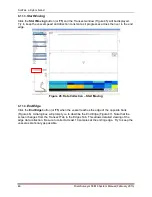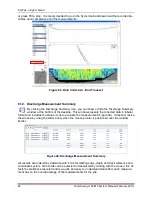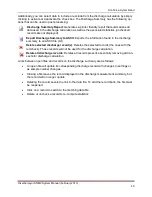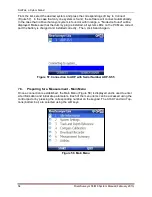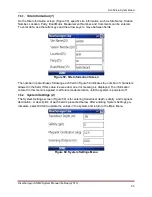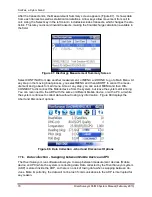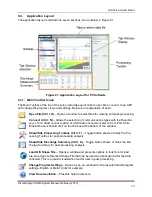
SonTek, a Xylem brand
58
RiverSurveyor S5/M9 System Manual (February 2013)
sociated with each measurement. The RiverSurveyor uses two types of differential
corrections: “Sub-meter” differential and “Real-Time Kinematic” (RTK).
3.
VTG GPS-referenced velocity: GPVTG (VTG) refers to a specific NMEA-0183 proto-
col for outputting GPS velocity data. In this case, the VTG string contains the actual
boat speed information along with several other GPS parameters. The GPS velocity
is calculated based on the Doppler shift of the received satellite signals.
Select the default track reference for the measurement. All available track references will be
available for analysis or to recalculate discharge in post-processing. There are four options:
•
Bottom-Track
: The ADP uses the bottom-track feature to measure the velocity of a ves-
sel relative to the river bottom. The vessel velocity is then subtracted from the measured
water velocity to give the absolute water current profile independent of vessel motion.
This is the only track reference available for systems without an optional GPS.
•
GPGGA
: The ADP uses the GGA string (from the GPS data) to measure velocity of a
vessel based on GPS position data. This is only available for systems configured with a
GPS option. It is recommended that GGA data use a sub-meter differential or RTK cor-
rection for discharge calculations. The highest quality and most accurate method ap-
plies RTK-corrected data.
•
GPVTG
: The ADP uses the VTG string (from the GPS data) to measure the velocity of a
vessel based on GPS velocity data. This method requires additional review of data qual-
ity parameters to verity data quality.
•
System
: The ADP references all velocities only to itself. This should only be used in
specialized applications by experienced users. It is
not recommended
for discharge
measurements from a moving vessel.
Depth Reference
– Select the default depth reference for the measurement. Both options are
available for analysis or to recalculate discharge in post-processing. There are two options:
•
Vertical Beam
: This is highly accurate echo sounder data used to determine water
depth.
•
Bottom-Track
: This uses data from the four angled beams to determine the depth of the
water column using the average depth from each beam.
Coordinate System -
Select the default coordinate system for the measurement. All options are
available for analysis or to recalculate discharge in post-processing. There are three options:
•
ENU
: This is the traditional East, North, and Up coordinate system.
•
System
: This uses the ADP as a reference. Used for internal testing only.
•
XYZ
:
This is a three-dimensional “relative position” coordinate system used only for spe-
cialized applications by experienced users.
7.6.4.
Compass Calibration (4)
A compass calibration is necessary prior to each discharge measurement to compensate for
magnetic fields specific to the site. When ready to perform the calibration, click START. Rotate
the ADP through two complete circles while varying pitch and roll angles as much as possible. It
is important to calibrate the compass on the boat or mount and as close to the measurement lo-
cation as possible. Be sure to remove any mobile phones, PDAs or other metal objects from the
area prior to calibration. Figure 64 shows the Compass Calibration menu.
Содержание SonTek River Surveyor M9
Страница 10: ......
Страница 118: ......
Страница 150: ...SonTek a Xylem brand 140 RiverSurveyor S5 M9 System Manual February 2013 Figure 126 Island Edge...



